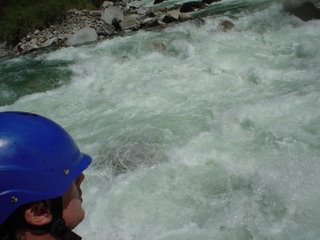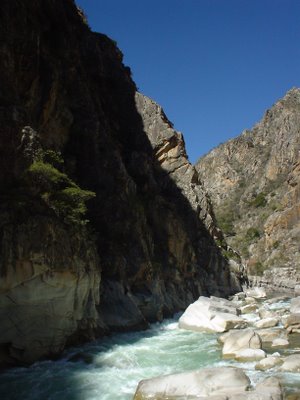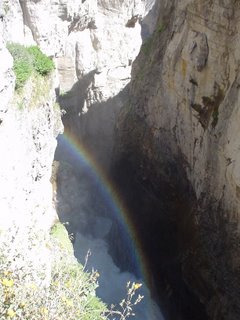 The Apurimac River is only a few hours outside of Cusco, and is one of the most sought after multi days in the country. But, to catch this worm you have to get up early. We caught a cab out of cusco at 5 am in route to a small town about 40 minutes down the road. A reliable source had told us that there was a truck that you catch at 6 am which would take you too the Apurimac. We arrived at about a quarter to six at a small roadside restraunt, which also happend to be the transportation terminal. The restraunt owner informed us that a bus arrived a bit after seven which would be able to take us too the river. So, we took the opportunity to fuel up on a classic breakfast of rice and chicken. Which was surprisingly good. At seven, everyone was out and about whizzing up and down the street on bicycles and mosquitos (which is a motorcycle taxi, for those not familiar). The Bus arrived soon after and was packed. I mean way over 200% capicity, and the roof rack was overflowing. We pleaded our case to the driver, but no empathy was recieved. He did inform us that another bus would be arriving soon that could also take us. The driver was correct, and within a few minutes another bus arrived. The second bus possiably had more people than the first. But fortunatly the driver was less concerned about personal space and other irrelevent issues such as structural carrying capacities. So, he encouraged us too strap our boats on top of the already loaded roof rack. We loaded our gear and joined the rest of the passengers of our bus. There were no seats, and too be fair, there were more people in the isles than seated. The next three and half hours we spent rallying toward the put-in on some of Peru´s finest secondary roads.
The Apurimac River is only a few hours outside of Cusco, and is one of the most sought after multi days in the country. But, to catch this worm you have to get up early. We caught a cab out of cusco at 5 am in route to a small town about 40 minutes down the road. A reliable source had told us that there was a truck that you catch at 6 am which would take you too the Apurimac. We arrived at about a quarter to six at a small roadside restraunt, which also happend to be the transportation terminal. The restraunt owner informed us that a bus arrived a bit after seven which would be able to take us too the river. So, we took the opportunity to fuel up on a classic breakfast of rice and chicken. Which was surprisingly good. At seven, everyone was out and about whizzing up and down the street on bicycles and mosquitos (which is a motorcycle taxi, for those not familiar). The Bus arrived soon after and was packed. I mean way over 200% capicity, and the roof rack was overflowing. We pleaded our case to the driver, but no empathy was recieved. He did inform us that another bus would be arriving soon that could also take us. The driver was correct, and within a few minutes another bus arrived. The second bus possiably had more people than the first. But fortunatly the driver was less concerned about personal space and other irrelevent issues such as structural carrying capacities. So, he encouraged us too strap our boats on top of the already loaded roof rack. We loaded our gear and joined the rest of the passengers of our bus. There were no seats, and too be fair, there were more people in the isles than seated. The next three and half hours we spent rallying toward the put-in on some of Peru´s finest secondary roads. As soon as we steped off the bus we were greeted by a swarm of natives. The natives didnt hesitate to attack, and immediatly our priority shifted toward swating these agressive motherf#€&$?s. The Apurimac is notorious for its ferocious sand flies which became apparant very quickly. All the locals knew these suckers had some teeth. a few young children were kicking a football around, and everyone of them was wearing a head net. I inquired with the gentleman who ran a small store by the bridge about head nets and he kindly offered a head net for the price of two soles( the equivelent of about 60 cents). Excited to be off the bus, we made our way to the river.
Within thirty minutes of being on the river we entered the first canyon. The river slightly narrowed and the canyon walls began to climb toward the sky. It was the first of the season and the river was high, so entering the canyon we were excited to see what lay between these dramatic rock walls. The river seemed to be mainly long rapids seperated by equally long pools. Floating into big water rapids is an aquired taste, that even when you enjoy it, should be consumed with a bit of trepidation. Combined with the late day sun every rapid looked similar from above. a horizon line of white explosions which was distorted from the glare. As you got closer to the lip the bottom often became apparant, and many times the line was obvious and the rapid very managable. But, every now and again you would float into something that the bottom wasn´t apparant. Which would entail locating an eddy within the rapid, or scrambling toward the bank to take a gander. At the top, as the sun is glarring you in the face, everything looks bigger than it is. And occasionally it is a bit bigger than it looks, but that is another story. That afternoon, we spent about three and a half hours making our way through the first Apurimac George.
we made camp above the second gorge. Fired up at how good the river was, we exited onto a nice beach as the sun departed the canyon for the day. ¨Most of the big rapids come the second day¨, was the extent of the information we had about the river. So tommorow was certain to be good. But, presently the task at hand was making dinner. And taking no prisoners in beach bochi ball. no prisoners were taken. And subsequently, we locked into a good bochi ball rally as dusk entered the camp..... after dinner we sat around enjoying the unique experience of being deep in a remote Peruvian canyon, when we saw the largest shooting star ever! it was one of those moments where three seconds in someone slowly say, ¨are you catchin this?¨ with the equally slow response of,¨oh....yeah.¨
Waking up on the river is an exceptional location to start the day. The light slowly emerges, while constantly changing until the sun shows its face for the day. After a leisurly breakfast, we broke camp and launched into the second gorge. The second gorge is not as dramatic in regards to vertical walls as the first canyon. But the rapids are stout. To our advantage the lighting was better, so it was much easier to scout from eddies. We had no problem making our way down, until in the middle of a big rapid i caught on eddy on the right without paying enough attention to what lie downstream. I signaled for Rob to catch an eddy on river left. He scouted his line and signaled that the left side was a go. When he got to the bottom, he signaled that the right channel had a big hole. At this point i was too commited downstream to make it left. The eddy i was in was deep and has surrounded by ten foot walls. Downstream there appeared to be a series of ledges. I could see the first two. But the bottom ledge was questionable and there seemed to be a suspect feature on the right that appeared to be sieve. After a bit speculation i was able to attain a higher eddie that had a really small ledge which i could get out on. With a bit of luck i was able to scale up the rock and pull my boat up. After scouting the rapid, the hole at the bottom appeared to flush through on the center left side. The top was pushier than i had anticipated but i was able to stay on line through the bottom. The second day proved to be incrediable. lots of big clean rapids. one big portage and one small one. The crux of the canyon was visually impressive, and i am slightly confused how they get rafts through a few sections. After lunch the valley opend up and eventually we arrived at the main road traveling from Lima to Cuzco.
The problem was we weren´t sure which direction Cuzco was. After an hour three cars had passed. two of them were busses, which indicated the direction of our destination. and the other car was going the other way. Neither bus had a roof rack, and even if they did, they were going so fast i don´t think they would have been able to stop. We had a few hours before dark, but after an hour not one potintial ride had passed. We had a little bit of oatmeal left over from breakfast, so we began planning to settle in for the night. And almost as soon as we verbally acknowledged our willingness to camp out by the road. An Angel came from the sky. Actually it was just a Tico (small cab) headed to Cuzco. I was so excited not too have to camp out by the interstate! Too add to our luck, he charged us ten dollars for the two and half hour ride back to Cuzco, which was so fair i could have done a dance on the spot. Actually, I think i did.
PICTURES: (above) taking a gander. (Below) ¨bread for sale.¨ the pinch, upper gorge. Rob, Floating into another exploding horizon line. o.k....you have my attention. Sequence. ten foot wall eddy. sometimes... a little luck never hurts. The cooliest cab driver in the world!
























